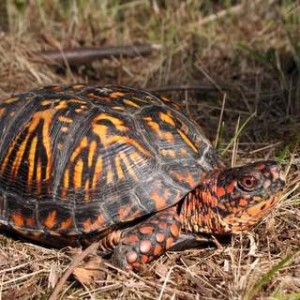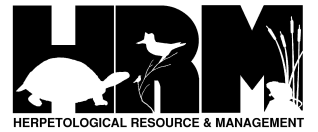Eastern Box Turtle
Overview:
Scientific Name: Terrapene carolina carolina
Size: 4.6 – 7.8,” rarely exceeding 6.3” (adult carapace length)
Status: Uncommon to rare and steadily declining throughout Great Lakes region. Historically quite common and widespread in woodlands of eastern Lake Michigan and western Lake Erie basins. Can remain locally common in intact habitat with low disturbance.

Habitat:
Deciduous or mixed woodlands, especially with sandy soils. Also will use adjacent thickets, old fields, pastures, vegetated dunes, marshes, and bog edges. Suitable habitat includes access to water and unshaded nesting sites. Highest densities observed in moist, open hardwood forest and forest/old field edges with relief topography, such as ravines or modest slopes.
Adult Coloration:
Carapace usually brown or black with radiating pattern of yellowish or orange spots, blotches, or lines in each scute. Lighter color may cover much of the shell in some, so that they appear yellow with dark markings. Plastron coloration can be solid black, brown, tan, or yellow, or any combination of these in blotches or streaks. Coloration on head, neck, and legs is variable as well, typically brown with some yellow, orange, or white spots or streaks. In some (usually males) lighter colors may predominate. Males can be distinguished by red eyes (irises), while females have brown or yellowish eyes.
Adult Characteristics:
Carapace domed (“helmet shaped”), plastron hinged. Carapace with slight central keel, scutes usually with prominent growth rings (annuli), though may be worn smooth. Males with flared rear carapace margins and concave rear lobe of plastron. Hind claws thick and quite curved in males, and tail is thicker and longer than in females.
Juvenile Characteristics:
Hatchlings have flatter, more circular carapaces that are brown or grayish brown with a light spot in the center of each scute. Carapace also may be uniform olive gray to grayish brown with central keel that may be lighter in color. Plastral hinge is nonfunctional. Carapace length ranges from 1 to 1.2”.
Species Confused With:
Blanding’s turtle also has a plastral hinge, but its elongated carapace is smooth and unkeeled, its upper jaw is notched (rather than hooked), and its throat and lower neck are usually bright yellow. The sometimes terrestrial Wood Turtle has a broader, less domed carapace, and its plastron lacks a hinge..
References:
- Amphibians and Reptiles of the Great Lakes Region by Jim Harding
- Harding, J.H. and J.A. Holman. 1990. Michigan Turtles and Lizards. MSU Cooperative Extension Service and MSU Museum. 96 pp.
- Ruthven, A. G., H. B. T. Gaige, et al. 1912. The herpetology of Michigan, by Alexander B. Ruthven. Crystal Thompson and Helen Thompson; Memoranda towards a bibliography of the archaeology of Michigan, by Harlan I. Smith; prepared under the direction of Alexander G. Ruthven. Lansing, Mich., Wynkoop Hallenbeck Crawford, State Printers.
- Holman, J. A. 2012. The Amphibians and Reptiles of Michigan: A Quaternary and Recent Faunal Adventure. Detroit, Mich., Wayne State University Press.
- Conant, R., and Collins, J. T. 1998. Reptiles and Amphibians: Eastern, Central North America. Houghton Mifflin Harcourt Press.
Credits:
- Jim Harding
